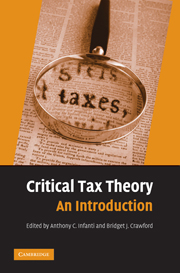Book contents
- Frontmatter
- Contents
- List of Illustrations
- List of Tables
- List of Contributors
- List of Common Abbreviations
- Introduction
- CHAPTER 1 FOUNDATIONS OF CRITICAL TAX THEORY
- CHAPTER 2 HISTORICAL PERSPECTIVES ON TAXATION
- CHAPTER 3 THE GOALS OF TAX POLICY
- CHAPTER 4 CRITICAL TAX THEORY MEETS PRACTICE
- CHAPTER 5 RACE AND TAXATION
- CHAPTER 6 GENDER AND TAXATION
- CHAPTER 7 SEXUAL ORIENTATION AND TAXATION
- CHAPTER 8 THE FAMILY AND TAXATION
- CHAPTER 9 CLASS AND TAXATION
- CHAPTER 10 DISABILITY AND TAXATION
- CHAPTER 11 GLOBAL CRITICAL PERSPECTIVES ON TAXATION
- CHAPTER 12 CRITICAL PERSPECTIVES ON CRITICAL TAX THEORY
- Index
CHAPTER 2 - HISTORICAL PERSPECTIVES ON TAXATION
Published online by Cambridge University Press: 04 August 2010
- Frontmatter
- Contents
- List of Illustrations
- List of Tables
- List of Contributors
- List of Common Abbreviations
- Introduction
- CHAPTER 1 FOUNDATIONS OF CRITICAL TAX THEORY
- CHAPTER 2 HISTORICAL PERSPECTIVES ON TAXATION
- CHAPTER 3 THE GOALS OF TAX POLICY
- CHAPTER 4 CRITICAL TAX THEORY MEETS PRACTICE
- CHAPTER 5 RACE AND TAXATION
- CHAPTER 6 GENDER AND TAXATION
- CHAPTER 7 SEXUAL ORIENTATION AND TAXATION
- CHAPTER 8 THE FAMILY AND TAXATION
- CHAPTER 9 CLASS AND TAXATION
- CHAPTER 10 DISABILITY AND TAXATION
- CHAPTER 11 GLOBAL CRITICAL PERSPECTIVES ON TAXATION
- CHAPTER 12 CRITICAL PERSPECTIVES ON CRITICAL TAX THEORY
- Index
Summary
When studying the evolution of tax law and policy, students and scholars typically study official records – decisions by judges, rulings and publications by administrative agencies, statements by elected officials, and legislative histories. These are the traditional tools for uncovering the “history” of taxation, and yet the story these official records tell is incomplete. The contributors to this chapter seek to fill the gaps in our understanding of the social and political meaning of taxation in everyday life. Historical perspectives on the Code yield multiple implications for our understanding of the tax system.
In her article Dollars and Selves: Women's Tax Criticism and Resistance in the 1870s, Carolyn Jones examines nineteenth-century news articles to explain how proponents of woman suffrage linked their claims to the right of women to vote with the unfairness of the tax system. As Jones explains, suffrage advocates used tax protests to draw attention to women's lack of power in the public sphere. Through these tax protests, women made claims both about their economic rights and their right to participate in public life. The very meaning of taxation, Jones reminds us, is historically contingent.
In her second contribution, Split Income and Separate Spheres: Tax Law and Gender Roles in the 1940s, Jones again looks beyond court cases and policy statements to reveal a rich history of an “official” tax story. Jones carefully studies newspaper articles, advertisements, and letters written by citizens to their elected representatives to understand the tremendous role that war, gender, and property rights played in the development in 1948 of the joint income tax return. She urges the reader to analyze the relationship between tax law and everyday “culture.”
- Type
- Chapter
- Information
- Critical Tax TheoryAn Introduction, pp. 11 - 12Publisher: Cambridge University PressPrint publication year: 2009



